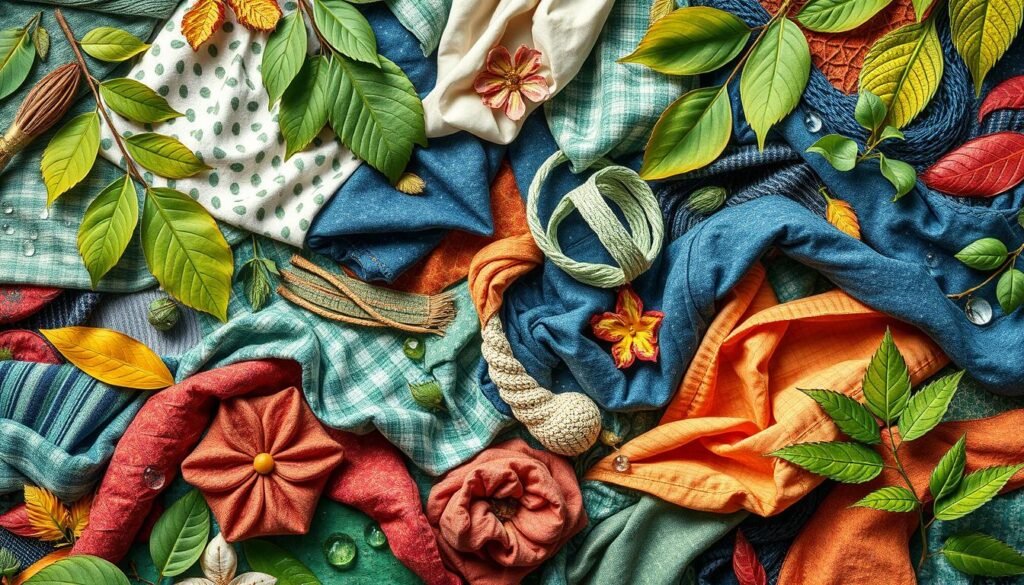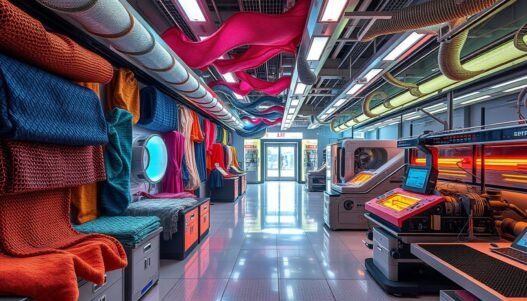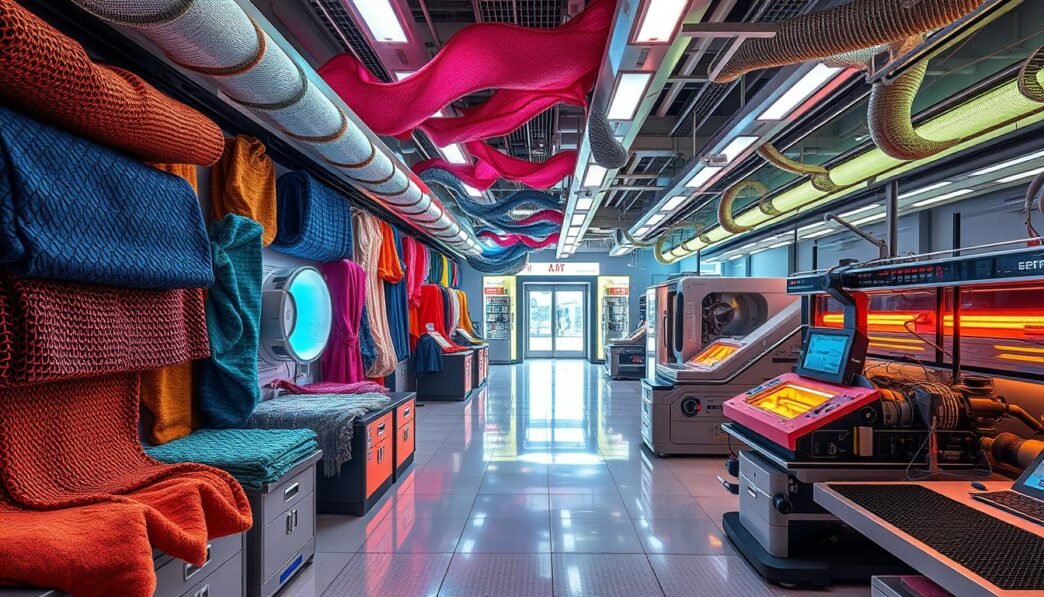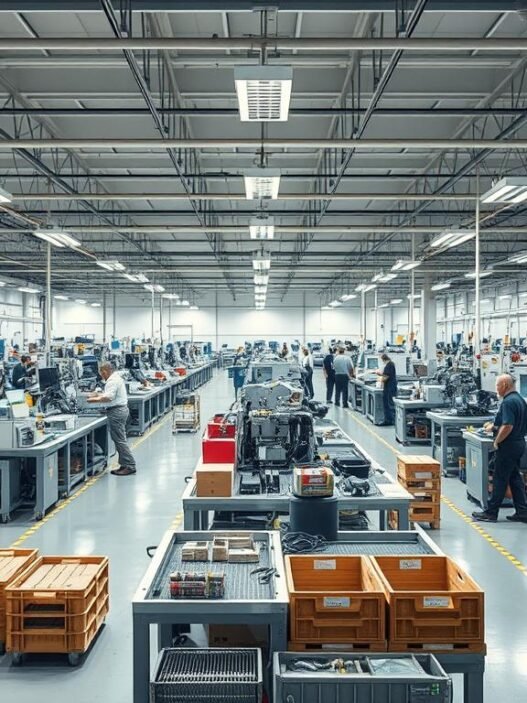Did you know that transport textiles make up nearly 20% of all technical textiles used? This shows how big of an impact advanced fabrics have today. They are not just fabrics; they are a new way of combining function with the latest materials.
In the medical and hygiene fields, over 23% of nonwoven textiles are used. In agriculture and horticulture, they act as protective coverings. Technical textiles are changing how we see fabrics. They are used for safety and to improve performance in sports and leisure.
As we look into intelligent textiles, we see their benefits in many areas. This shows how important they are for today’s innovations.
Let’s dive into the world of technical textiles. We will explore their features, importance, and future. This will help us understand how these advanced fabrics are changing industries.
Key Takeaways
- Transport textiles represent about 20% of total technical textile usage.
- Medical and hygiene textiles account for over 23% of nonwoven use.
- Technical textiles are widely used in agriculture for protection and containment.
- Protective textiles safeguard against a variety of hazards.
- Sports and leisure industries benefit greatly from advanced textile technology.
- Carolina Performance is a leader in the technical textiles industry with over 175 years of experience.
- Innovations in intelligent textiles are shaping the future of fabric technology.
Introduction to Technical Textiles
Technical textiles are special fabrics made for top performance and function. They are not just for looks. They meet the needs of many industries like medicine, military, construction, and fashion.
There are many types of technical textiles, each with its own job. For example, clothtech is used in clothes and shoes, making up about 7% of the industry. On the other hand, mobiltech is crucial in cars, used in airbags and filters. These fabrics are becoming more common in many areas.
“These specially manufactured fabrics are designed with specific attributes and performance benefits in mind.”
Medical textiles are also key, with products like PPE, surgical clothes, and smart health tech. The technical textiles market is growing fast, about 4% each year. Some main types include:
| Type of Technical Textile | Applications |
|---|---|
| Agro tech | Shade nets, crop protection covers, weed reduction mats |
| Med tech | PPE gowns, smart healthcare products, surgical fabrics |
| Mobil tech | Airbags, seat covers, insulation in vehicles |
| Pro tech | Safety clothing, protective gear for hazardous environments |
| Indu tech | Filters, conveyor belts, industry-specific components |
Technical textiles are leading to new innovations in fabrics. Learning about them helps us see their big role in today’s tech.
Revolutionizing Fashion with Innovative Fabrics
Technical textiles are changing the fashion world by making clothes better and more comfortable. Fashion innovation comes from new materials like moisture-wicking and breathable fabrics. These allow designers to mix style with practicality.
The benefits of technical fabrics include self-cleaning and getting stronger with each wear. This helps both people and the planet by supporting green practices.
Now, we see smart textiles that mix old fabric with new tech. These materials can change based on their surroundings. For example, clothes with sensors can track health and fitness.
We also have clothes that light up or change color, showing the cool side of technical textiles in fashion. Even fabrics that can charge devices are being explored. This adds a cool, futuristic twist to fashion.
These fabrics are not just stylish but also meet different needs. They’re made from recycled or biodegradable materials, showing the industry cares about the planet. Companies are leading the way, making clothes that are both trendy and eco-friendly.
To learn more about how tech is changing fashion, check out sustainable clothing materials.
Understanding the Characteristics of Technical Textiles
Technical textiles are special because they have amazing features that go beyond what regular fabrics can do. They are known for being moisture-resistant, breathable, durable, and even smart. These traits make them perform better in many ways.
These fabrics can handle water well, which is great for outdoor and protective clothes. They also last a long time, which is key for construction and car industries. Being breathable keeps us cool, and they can even help control our body temperature.
Smart technologies are becoming a big part of technical textiles. They can monitor our health and control temperature in real-time. This shows how these fabrics are getting even better for many uses, from health to farming.
Knowing what makes technical textiles special helps both makers and buyers choose the right fabrics. As the market keeps growing, these unique features will keep making technical fabrics popular in many areas.
Applications of Technical Textiles in Various Industries
Technical textiles are now widely used in many fields. They bring new solutions and better performance. In the medical field, they are used in surgical gowns, wound care, and orthopedic supports. These textiles improve patient care and comfort.
In the automotive sector, technical textiles are crucial. They are in seat covers, airbag systems, and sound insulation. This makes cars safer and more comfortable. About 23% of technical textiles are used here.
The construction industry also uses technical textiles. They make buildings stronger and more durable. Geotextiles, for example, help stabilize soil and prevent erosion.
Protective clothing is in high demand. This is because people want to stay safe at work and in other places. Technical textiles help make this clothing, like military uniforms and medical gear, better.
The sports industry is also growing. More people are into sports and fitness, which means they need better gear. Products like artificial turf and advanced composites are changing the game.
- Medical Textiles: Surgical gowns, wound care items, orthopedic supports.
- Automotive Textiles: Seat covers, airbag systems, sound insulation.
- Construction Textiles: Geotextiles for soil stabilization, building insulation fabrics.
- Protective Clothing: Military uniforms, industrial safety gear.
- Sports Textiles: Advanced sportswear, artificial turf.
Technical textiles are changing many industries. They improve safety, performance, and how long things last. This shows how important these fabrics are for progress.
Performance Enhancement through Advanced Materials
Performance enhancement textiles are changing many industries. They offer strong solutions to make things work better and feel more comfortable. Materials like moisture-wicking fabrics and UV-resistant textiles help athletes and outdoor lovers. These fabrics are durable and make things better for many uses.
Key advantages of performance enhancement textiles include:
- Improved breathability, allowing for airflow during intense physical activities.
- Water resistance, ensuring the wearer stays dry in adverse weather.
- Flexibility, enabling unrestricted movement, crucial for sports and outdoor gear.
- Thermal insulation, protecting against extreme temperatures.
Materials like Nomex are great for staying cool in hot situations. Bio-polymers are good for the planet and fit with what people want today. These fabrics are light, making them perfect for sports clothes. They help you perform better without feeling heavy.
Here’s a comparison table illustrating various characteristics of advanced materials in textiles:
| Material | Main Feature | Application |
|---|---|---|
| Nomex | Heat resistance | Firefighter gear, industrial protective clothing |
| Bio-polymers | Eco-friendliness | Outdoor apparel, medical supplies |
| Moisture-wicking fabrics | Moisture control | Activewear, athletic wear |
| Impact-resistant textiles | Safety enhancement | Sports gear, outdoor equipment |
| Compression fabrics | Muscle support | Recovery garments, athletic apparel |
Technical textiles are getting better all the time. They aim to make our daily lives better, from sports to work. With new tech, makers keep improving, focusing on safety and doing better.
Technical Textiles and Sustainability Initiatives
The push for sustainable textiles is growing fast in the textile world. Now, technical textiles are made with green practices and recycled stuff. Things like biodegradable fabrics show we’re moving towards greener options, helping the planet.

New ways to make materials are coming up, like fabrics that dissolve in water. This cuts down on waste. Also, self-cleaning clothes are now a thing, saving water and energy when we clean them.
- Sustainable practices are key now, with more people wanting eco-friendly clothes.
- Scientists are working on using natural stuff to make technical fabrics.
- The goal is to use 20% recycled materials in technical textiles by 2025.
| Material Type | Environmental Impact |
|---|---|
| Dupont Sorona | Needs 30% less energy and cuts greenhouse gases by 56% compared to Nylon 6 |
| Coolmax EcoMade | Made from 97% recycled stuff, helps manage moisture better |
More sustainable textiles mean we’re listening to what consumers want and following rules. Companies are fast to change, making a greener future. They keep working on new, eco-friendly tech fabrics, showing they care about the planet.
High-Performance Functional Textiles with Diverse Applications
High-performance textiles are key in many industries. They help solve specific problems with new technologies. For example, firefighting gear keeps firefighters safe and mobile in tough conditions. Medical textiles, like non-toxic and sterile materials, are vital in healthcare.
In sports and fitness, these textiles are a game-changer. They keep you dry and cool, making your workout better. The demand for these textiles is growing, thanks to their ability to manage moisture and control odors.
As industries grow, so do the needs for smart textiles. These textiles can even charge devices and connect to the internet. This opens up new possibilities for the future.
Some examples of these textiles include:
- Flame-retardant fabrics for firefighting, kids’ sleepwear, and furniture.
- Surgical drapes in operating rooms, made from non-woven materials.
- Protective textiles for healthcare workers to prevent contamination.
Developed countries like the US and Japan lead in making technical textiles. They make up over 35% of their textile output. India, with a 5% share, sees a big opportunity for growth with its 8% annual economic increase.
The market for functional textiles is expected to grow, focusing on green solutions. Asia-Pacific and Latin America are seeing rapid growth, thanks to urbanization and changing lifestyles. The book “Functional and Technical Textiles” provides insights into these trends.
| Region | Market Share (%) | Growth Rate (%) |
|---|---|---|
| USA | Over 35% | 5.2% |
| China | 19% | 6.8% |
| India | 5% | 8% |
| Japan | Over 35% | 2.9% |
The need for high-performance textiles is growing fast. This will lead to more innovations in adaptive textiles. These advancements will shape the future of many industries.
Exploring Smart Textiles and Wearable Technology
Smart textiles are a big step forward in fabric innovation. They mix clothes with modern tech to make clothes that change with their surroundings. This integration of electronics in textiles opens up new uses, especially in health and wellness.

Active smart fabrics use materials like shape memory alloys and electroactive polymers. They can feel changes in their environment and react. Passive smart fabrics, on the other hand, just watch and collect data. They use conductive materials for things like UV protection.
In healthcare, smart textiles are key for always watching vital signs. These advanced fabrics give insights into heart rates, breathing, and overall health. They send real-time health data through textile sensors.
Comparison of Smart Textile Types:
| Active Smart Fabrics | Passive Smart Fabrics |
|---|---|
| React to environmental changes | Monitor and collect data |
| Use materials like shape memory alloys | Incorporate conductive materials for UV protection |
| Applications in responsive clothing | Functions like environmental sensing |
Smart textiles can also make clothes that change based on what you want. This is great for fitness and sports, helping improve posture and health.
But, making smart textiles on a big scale is still a challenge. Scientists are working hard to solve these problems. They want to make smart textiles in a way that’s good for the planet.
New tech includes wearable displays for hearing loss, textile controllers for games, and smart carpets. These advancements show a future where clothes do more than just look good. They’ll keep an eye on your health and make life better.
Investments and Market Trends in Technical Textiles
The technical textiles market is growing fast. This is because people need fabrics that are strong and do many things. In 2023, it was worth USD 164.3 billion. By 2030, it’s expected to reach USD 243.2 billion.
Asia Pacific leads the market, with a 36.03% share in 2022. Countries like India are growing quickly. This shows how important it is to focus on local growth in technical textiles.
Big names like Asahi Kasei Corporation, Dupont, and Berry Global are key players. They help the market grow by improving production and meeting customer needs. Working together and getting government support keeps the industry strong and looking to the future.
The market is also split into different areas, like mobiltech, which was the biggest in 2022. The need for strong fabrics in cars and planes means more investment in new ideas. This shows how important it is to keep improving and making things better for the planet.
Knowing about current trends and what’s coming helps businesses stay ahead. By planning for the future of technical textiles, companies can find new chances and stay competitive.
Future Prospects and Innovations in Textiles
The world of textiles is changing fast. This change comes from future innovations in textiles that use technology, care for the planet, and explore new materials. As these trends in textile technology grow, they will change how we see and use fabrics.
Big brands are now making clothes with cool tech. For example, some shirts and jackets can track your heart rate and breathing. This is just the start of what smart textiles can do.
There’s a big focus on making things better for the environment. New materials come from things like organic waste, algae, and fungi. For example, Q-Cycle by Fulgar® uses old tires to make new fabric. This helps reduce waste and makes clothes that break down faster.
How we make clothes is changing too. We’re using less water and more green energy. New fabrics are coming out that can fight stains and keep you healthy. These changes help clothes do more than just look good.
- Protective textiles offer safety from heat and radiation.
- Geotextiles enhance structural integrity in civil engineering.
- Agro-textiles provide crucial agricultural support.
The market for technical textiles is growing fast. It’s expected to grow by 6.85% each year. This could make it worth USD 360.26 billion by 2030. This growth shows how important it is to keep working on new textile ideas.
Looking to the future, 3D printing is changing the game. It lets us make clothes in a way that’s good for the planet and cuts down on waste. As technology, care for the planet, and performance keep improving, we can expect even more cool things in the world of textiles.
Conclusion
Technical textiles play a big role in many areas, not just fashion. They are making big changes in healthcare, safety, and helping the environment. These materials are key in meeting today’s needs, from clothes to construction and medical tech.
These fabrics are known for being strong, lasting, and good for the planet. In fields like Medtech, Mobiltech, and Ecotech, they’re setting new high standards. They help make things more sustainable and cut down on harm to the environment. With a growth rate of about 4% each year, they’re shaping the future of fabrics.
As research and tech keep improving, we can expect even more from technical textiles. They will keep leading the way in fabric evolution. They will tackle today’s and tomorrow’s challenges in our fast-changing world.















